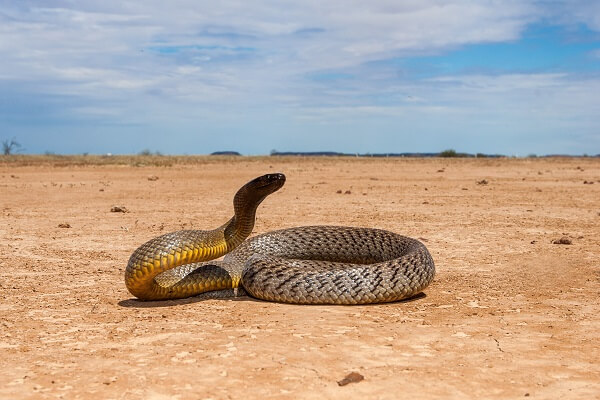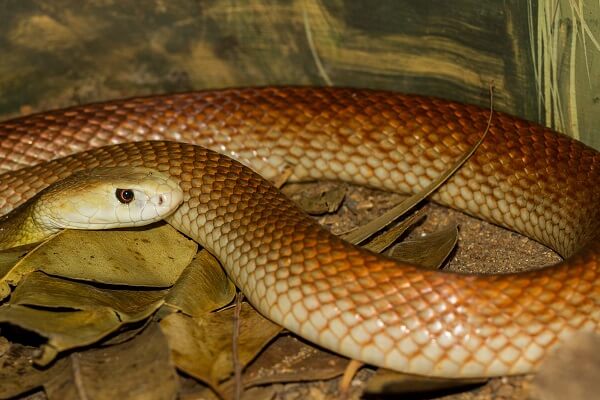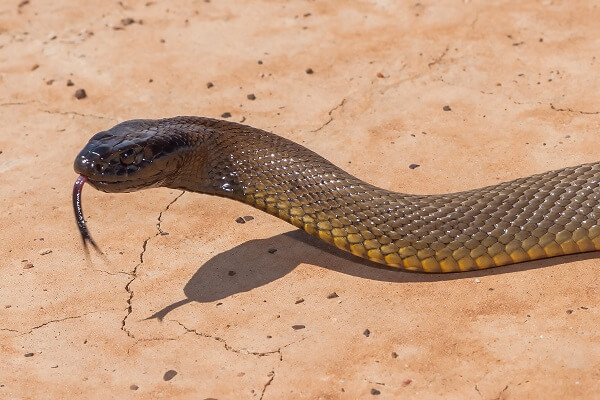
Taipan snakes (genus Oxyuranus) are three species of snake endemic to Australia and New Guinea. These snakes are large, fast-moving, and highly venomous. One species – the inland taipan or fierce snake -is widely known as having the most toxic venom of any terrestrial snake in the world. Taipan snakes range in color, from beige to grey, and pale brown to dark brown. They are mainly rodent eaters and are commonly seen on sugarcane plantations and other areas that have large populations of rats and mice. The coastal taipan (Oxyuranus scutellatus) – also known as the common taipan – is the largest of Australia’s elapid snakes. It commonly reaches lengths of 6 – 8 ft (1.8 – 2.4 m), although sometimes it can reach a maximum length of 9.5 ft (2.5 m). This snake is found n the coastal regions of northern and eastern Australia and the island of New Guinea. This snake is not usually confrontational, but it is quick to defend itself if it is disturbed and will attack if cornered. The inland taipan (Oxyuranus microlepidotus), which is also known as the western taipan, the small-scaled snake, or the fierce snake is smaller than the coastal taipan. It is endemic to the semi-arid regions in central Australia. This snake averages 5.9 ft (1.8 m) in length, although some snakes have been recorded as reaching sizes of up to 8.3 ft (2.5 m). Inland taipans produce 12 – 20 eggs, which are often laid in disused animal burrows. The eggs incubate for two months. The third species of taipan, the central ranges or western desert taipan (Oxyuranus temporalis), was first described in 2006. It was discovered in the desert east of the Walter James Range in Western Australia. Little is known on the ecology of this snake, but it is thought to feed mostly on mammals, like the other taipan snakes. It is also highly venomous, although its venom is believed to be quite different from the venom of the other two species. The taipan is most famous for its deadly venom, but several other biological adaptations make this snake amazing to study. Let’s take a closer look! We can’t discuss the biology of a taipan without talking about the venom that this snake produces. All three species are highly venomous. The inland taipan has the most toxic venom of any land snake, and unlike a lot of other snakes, it almost always injects venom when it bites its prey. Taipans have two short fangs that are fixed in place. They are hollow teeth, much like hypodermic needles, which fill with venom from two venom glands that are located on either side of the snakes head. The inland taipans venom can kill an adult man in 30 to 45 minutes without treatment. The coastal taipan is the third-most venomous land snake after the inland taipan and the Eastern brown snake. The taipan venom contains pre- and postsynaptic neurotoxins, myotoxins, and procoagulants, which result in a quick and painful death. Neurotoxins can cause paralysis or muscle weakness, whereas myotoxins cause myolysis, which is the destruction or disintegration of muscle tissue. Procoagulants are toxins that interfere with the blood-clotting process, which puts its victims at risk of major bleeding. Taipan procoagulants are the strongest procoagulants discovered in snake venom. Luckily, there is an antivenom available, but if a taipan bites you, you must act fast. The potency of their venom means that taipans can capture their prey fast. The snakes corner their victim and strike, injecting venom straight away. They then let go and wait for the prey to become immobile. This protects them from the claws and sharp teeth of their prey. Studies on the venom of the inland taipan have shown that a single bite contains enough venom to kill 250,000 mice! Aside from their deadly venom, these snakes are also excellent hunters. They have excellent sense capabilities, using their tongue to gather information on the location of their prey. They flick their tongue rapidly in and out of their mouth, which enables them to pick up scent particles in the air or on the ground. Scent particles are usually chemical signals such as pheromones. The snakes pick up these scent particles on their tongue and pass this to the Jacobson’s organ, through two small cavities located in the roof of their mouth. The Jacobson’s organ, otherwise known as the vomeronasal organ, is a sense organ that is a part of the olfactory system. It is present in all snakes and lizards and some mammals, including cats and dogs. It is also present in humans but is vestigial and doesn’t function. Nerves from this organ connect it to the olfactory lobe of the brain. When the organ receives the chemical signals, a signal is sent to the brain that enables them to locate where the prey animals are. Taipan snakes are found in some of the harshest conditions in the world. To inhabit these areas, they have developed adaptations that help them to survive in high temperatures. Like all reptiles, snakes are ectotherms, which means that the environment around them controls their body temperature. Taipans can change the color of their skin and scales to keep cool or to retain heat. In the summer, taipans are lighter in color. This helps them to keep cool as light colors reflect heat. In the winter, the skin and scales are darker in color. This enables the snakes to absorb as much heat as possible and keep their body warm.
Kingdom
Animalia
Phylum
Chordata
Class
Reptilia
Order
Squamata
Family
Elapidae
Genus
Oxyuranus
Species
3
Niche
Carnivorous; eats small mammals and birds
Length
Varies, largest is coastal taipan, which can reach 9.5 ft (2.9 m). The inland taipan is smaller – reaching up to 5.5 ft (1.7 m).
Weight
Inland taipan: 1- 2 kg, Coastal taipan: average is 3 kg
Lifespan
10 – 15 years
Social Structure
Solitary except for during mating
Conservation Status
Least Concern
Preferred Habitat
Variety of different habitats dependant on the species
Average clutch Size
3 – 20 eggs
Main Prey Species
Rats, mice, and bandicoots.
Predators
Other snakes, including the mulga snake and the king brown snake
The Basics
Species of Taipan

Interesting Insights from the Taipan Snake!
Venom

Jacobson’s Organ

Color Change
